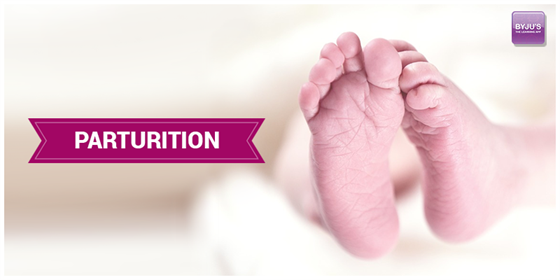Parturition is another word that describes childbirth. Both labour or delivery terminologies refer to Parturition. Overall, parturition is the final stage of the pregnancy, which every woman has to undergo to delivery a baby. During this period, a baby grows inside a woman’s uterus.
Let’s learn in detail about the Parturition and the three different stages of parturition.
Table of Contents
What is Parturition?
Parturition means childbirth. It is also known as labour. It is the mechanism of signalling the onset of labour (or) a procedure of delivering a child after the completion of pregnancy period. The developed child is born with the release of cortisol.
During parturition process, the cervix dilates and relaxes. Along with cortisol, oxytocin and estrogen hormones are released to begin the milk production and labour.
During parturition, the uterus contracts to push the fetus towards the cervix and continues until the fetus comes down the birth canal. In this process, the head should be first to come out.
After parturition, the uterus releases the placenta and it passes out immediately after the fetus is born. Lactation begins and the first milk is called colostrum. This milk contains antibodies, which is required for a newborn baby to protect it against infectious diseases and other allergies.
Also Read:Lactation

Signs and Symptoms of Parturition
The signs of Parturition includes:
- Bloated abdomen.
- Mucous discharge.
- Feeling relentlessness.
- Labour and Contractions.
- Fully swollen vulva and relaxed pelvic ligaments.
- Development of mammary glands along with milk secretion.
Also Read: Pregnancy, Parturition and Lactation
Stages of Parturition
There are three stages of Parturition, which includes:
Dilation
This stage begins with the onset of labour and continues until the cervix is completely dilated. Dilation is divided into two phases:
- Latent Phase: When the cervix dilates 0-4 cm.
- Active Phase: The cervix dilates by 4-10 cm.
The latent phase takes around 6 hours for a female delivering the baby for the first time and is around 5 hours for the female delivering for the second time.
In the active phase, the cervix dilates at a rate of about 1 cm per hour for a lady delivering for the first time and is 2 cm per hour for a lady who is delivering for the second time.
Expulsion
This stage starts at full dilation and continues until birth. This stage is also divided into two phases:
- Passive Phase: In this phase, the baby’s head starts moving out of the vagina.
- Active Phase: In this phase, the mother contracts the abdominal muscles along with the uterine contractions.
This stage ends with the childbirth and the umbilical cord is clamped.
Placental
In this stage, the placenta is removed and the contractions of uterus decrease simultaneously.
Hormones involved in Parturition
The female hormones involved in parturition include:
- Estrogen: This plays a major role in uterine contractions.
- Oxytocin: It helps in the uterine contractions during parturition and the release of milk during breastfeeding.
- Relaxin: It relaxes the pelvic ligaments and widens the cervix.
- Prostaglandin: It is synthesized within the amnion and chorion and facilitates cervix ripening, changing the membrane structures and contraction of the myometrium.
Also Read: Sexual Reproduction
Important Questions
Q.1. List out the functions for the following female reproductive organs – Vagina, Uterus, Ovaries and Oviduct.
Listed below are the functions of female reproductive organs:
- Vagina: It functions as both reproductive and excretory organ.
- Uterus: It is also called the womb. It is the muscular organ where a fetus develops and grows.
- Ovaries: A pair of ovaries produce a female hormone called estrogen and is also involved in ovulation.
- Oviduct: It is also called as the Fallopian tubes. They are the sites of fertilization and also functions by connecting ovaries with the uterus.
Q.2. Which hormones are released during the process of parturition?
During the process of parturition or the childbirth oxytocin, estrogen and cortisol hormones are released.
Q.3. Which hormones are responsible for ovarian changes during the menstrual cycle?
Luteinizing hormone -LH, follicle-stimulating hormone-FSH and progesterone are three main hormones responsible for ovarian changes during the menstrual cycle.
Q.4.List out the three stages of Parturition
There are three stages of Parturition:
- Dilation.
- Expulsion.
- Placental.
Q.5.Which hormone is involved in the contractions of uterine?
Estrogen, the primary female sex hormone is primarily involved in the contractions of uterine.
Recommended Video:
Parturition Class 12 Biology (Childbirth) – Human Reproduction Concepts

Learn more about Parturition, stages of parturition, and the hormones involved in parturition only at BYJU’S Biology

Comments